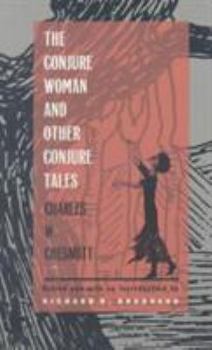The Conjure Woman and Other Conjure Tales
Select Format
Select Condition 
Book Overview
The stories in The Conjure Woman were Charles W. Chesnutt's first great literary success, and since their initial publication in 1899 they have come to be seen as some of the most remarkable works of African American literature from the Emancipation through the Harlem Renaissance. Lesser known, though, is that the The Conjure Woman, as first published by Houghton Mifflin, was not wholly Chesnutt's creation but a work shaped and selected...
Format:Paperback
Language:English
ISBN:0822313871
ISBN13:9780822313878
Release Date:October 1993
Publisher:Duke University Press
Length:216 Pages
Weight:0.79 lbs.
Dimensions:0.6" x 5.7" x 9.3"
Customer Reviews
3 ratings
Fantastically charming
Published by Thriftbooks.com User , 16 years ago
I bought the entire Library of America a few years ago, and have regularly been sampling and greatly enjoying most of the fiction authors in the series (as well as some of the non-fiction writers) ever since. But I was stymied the first time I tried to read The Conjure Woman. Most of the book is slavery-era folk tales or fantasies, presented as absolute fact in heavy Negro dialect by an elderly black servant who new white landholders "inherit" when they come South from Ohio and buy an old grape plantation in North Carolina. There is always a backdrop to the stories that relates to the white plantation owners (a transplant from Ohio and his somewhat sickly wife); the man who owns the estate is the first person narrator throughout. The first time around, I just didn't have the patience to slog through the dialect and try to figure out what old Julius, the servant was saying. But since I had also been initially stopped by other writers in the series, then loved them once I gave them a devoted effort, I finally decided to give Chesnutt and Julius a second try. And boy am I glad I did!! In a way, it reminded me of one of my other favorite works from the series, The Pastures of Heaven, by John Steinbeck. Like this book, it is about an abandoned farm that acquires a new owner, and both books are a connected set of weird short stories that are great individually but also have cumulative effect taken together, and have a fascinating and spooky larger story to tell. While Steinbeck's book is more sinister, Chesnutt's has more charm, as one consistent thread throughout is the suggestion that old Julius always has an immediate reason for telling (inventing?) each strange and scary tale that he tells. Sometimes, it is strictly to advance Julius' own interests -- while on other occasions it is based on influencing events affecting his white employers and their loved ones in a way that is very helpful to all. In the end, old Julius seems to be a kind of beneficent manipulative genius with his fantastic and persuasive tales. I am very stingy with my stars and have only ever given but a few 5's, but I can say that this is at least a 4+. The book is so perfect in achieving its intention, and Chesnutt is such a genius himself, I'm surprised I never heard of him before!! And, after getting used to the slave-Negro dialect, I grew to much enjoy reading it (most of the book is in this dialect, as the plantation owner records Julius' stories as he told them). It is so colorful, expressive, and humorous.
Uncle Remus turned upside down!
Published by Thriftbooks.com User , 19 years ago
In some ways, this could be seen as the flipside to the Uncle Remus stories(which celebrated many aspects of plantation life). Chesnutt, the first African-American known to write a large number of shiort stories, tells the tales of Uncle Julius McAdoo, who tells his white employers tales of slavery with harrowing underpinnings about seperation of families and other hardships, usually in an ironic style. Considering that these stories were written in the 1890s when sentiental tales of plantation lifewere popular, this is a significant piece of work-buy it.
A must for anyone interested in African American Literature
Published by Thriftbooks.com User , 22 years ago
What is most interesting about these stories is both the narrative framework & the way the narrator of the stories about the black community (there are essentially two narrators) uses magic ("The Goophered Grapevine" and "Po' Sandy" especially) to usurp the authority of the white landowner (the primary narrator, who is re-telling the stories Julius has told him). Maybe it takes an understanding of African American literary traditions-- signifying, call & response, etc, to really dig in, but you can still relate without that background. There are multiple layers of narration going on-- and once you can get through those layers, you can both enjoy the story-line and understand something pivotal about the way the African American genre works. The dialect and speech patterns are represented in a way that was criticized by some early African American writers who wanted a more "realistic" "naturalistic" and political structure. But underneath the "quaint" nature of the stories about magic & the slave/master relationship are some very subtle and very powerful images of how the slave and master influence *each other*-- that there are differences in the power dynamic than what we expect. It might be hard to get into the language-- but once you do, it's not overdone. Read the dialect the way you would learn another language; it's English, with a twist. There is also a great story on "passing," and some exploration of voodoo. This is a text that should be taught alongside Faulkner & Flannery O'Connor-- another look at the South.





